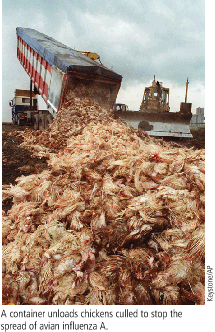NEWS
Farmers kill 23 million birds to stop influenza virus
Charlene Crabb
Paris
European health officials are continuing to monitor an outbreak of a highly pathogenic strain of avian influenza A (H7N7) that has claimed the life of a Dutch veterinarian and resulted in the slaughter of more than 23 million chickens and other fowl in the Netherlands and Belgium. Since its discovery at six poultry farms in central Holland on 28 February, the virus has also caused eye infections and mild flu-like symptoms in more than 80 people, most of them workers involved in the culling operations.
Experts worry that if the bird flu continues to infect people, it could exchange genes with a human influenza virus and create a strain that is either more contagious or more virulent or both toward humans. Known as "antigenic shift", gene swapping between animal and human influenza viruses occurs relatively rarely, but it has led to some of the deadliest flu epidemics in history.
So far, however, there is no evidence that the Dutch outbreak has unleashed a new and dangerous human bird influenza hybrid. The virus that killed the 57-year old veterinarian on 17 April, days after he visited a contaminated poultry farm, was genetically identical to the virus killing chickens. "The virus was not at all mutated," says Jim van Steenbergen, coordinator of Communicable Disease Control for the Netherlands, in Utrecht. Why the veterinarian's illness progressed from mild flu-like symptoms to severe massive bilateral pneumonia remains a mystery which researchers are investigating.
It is known that the man who died and most of the people infected with the bird flu failed to follow the protective measures that Dutch authorities had listed to prevent humans from becoming infected. Initially, people involved in culling chickens were obliged to wear protective goggles and clothing and facemasks. But after the first cases of eye infections were reported, which included three family members who had never come in contact with infected birds, health officials ramped up the measures to include flu vaccinations and taking oseltamivir, a drug which stops viruses replicating. About 1500 people, including farmers and families on contaminated farms, have been vaccinated.
The Dutch authorities acted immediately to stop the virus circulating among chickens as well, imposing restrictions on the movement of poultry, poultry manure and eggs throughout the Netherlands and abroad. But the virus has spread to more than 240 farms and crossed the southern border into Belgium. Birds from more than 1000 farms have been sacrificed. And pigs, which can simultaneously harbour avian, swine and human influenza viruses, are being sent to slaughter early if they test positive to the avian virus.

Before the outbreak, the Netherlands was home to more than 100 million chickens. It is the world's largest egg exporter and the European Union's biggest poultry exporter. Despite the size and density of its poultry and egg industry, the country has had no outbreak of avian influenza in three decades. In recent years, however, researchers at Erasmus University in Rotterdam found bird flu within Dutch borders in migrating waterfowl, which are the natural reservoir for avian influenzas. Scientists suspect the current outbreak originated when domesticated birds came in contact with droppings of wild waterfowl.
The culling of flocks in the Netherlands and Belgium dwarfs the well-publicized 1997 slaughter of all chickens some 1.4 million birds in Hong Kong following an outbreak of avian flu A(H5N1) that killed 6 people. In February this year, WHO confirmed that the virus had resurfaced in two members of a Hong Kong family who had recently visited south-eastern China. The 9-year old boy recovered, but his father died. The boy's younger sister died in China of similar symptoms, but it is not known if she was infected with virus. 
